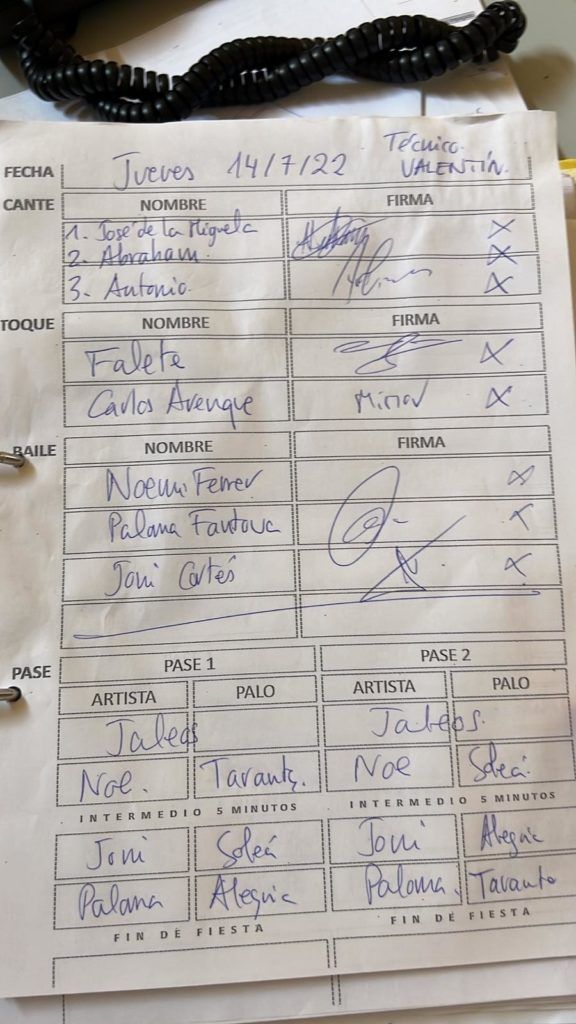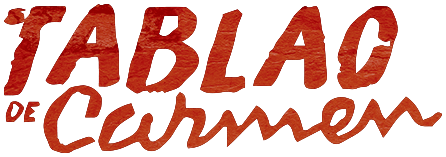The etymological definition of “spectacle” could differ from what we, from the Tablao de Carmen, consider to be the essence of Flamenco as a manifestation of musical artistry and as a culture.
The word “spectacle” comes from the Latin “spectare”, which means “to see” and “to contemplate”.
Furthermore, according to the Spanish Royal Academy, the Spanish word for spectacle, “espectáculo,” is defined as “a public performance or entertainment held in a theater, circus or any other building or place where people gather to witness it”.
From a private setting to a public performance
The public place to witness a flamenco show with dancing the tablao.
The most legitimate manifestation of flamenco is the private environment, the intimate urgency in the solitude of expressing oneself through singing, the intimacy of a family party. Thus, it would be logical to state that it is in clear distinction with the condition of “public presentation” innate to any show.
Although flamenco was born without an audience, its strength and its extraordinary attractiveness have made it an art admired by those who live it, and it has been elevated over time to stages all over the world.
In the tablaos, the artists do not rely on rehearsal or choreographies. This dynamic leaves the show in the hands of the rhythm, personality and connection between its actors: the flamenco artists, singers, dancers and guitarists.
The flamenco show in a tablao is essentially different from other flamenco shows in festivals or theaters. Apart from presenting the artists on stage, the tablao preserves the atmosphere of the first places where these shows began with the presence of seats around tables, tapas and food accompanied by drinks…..it demands and creates an atmosphere that does not exist in a theater.
The Tablao is, without a doubt, the natural public place for flamenco dancing.
Flamenco shows in Barcelona
It is known that the first flamenco shows occurred in the corners of taverns and bars, where a circle would form around a group of singers. Those who were called to sing were accompanied by the playing of a guitar. This livened up the atmosphere and attracted more customers. The birth of these singing groups brought about the dances and then, the elevated stage to reach all the spectators. Soon, the artists became professionals, turning flamenco into a means of earning a living.
In Barcelona, at the beginning of the 20th century, there were more locales with flamenco shows than in any other city in Spain. And today in Barcelona there are several tablaos that are part of the history of the city.
In the summer of 2020, after the crisis suffered by the Covid pandemic, three of the oldest tablaos in Barcelona joined together to form the “Plataforma de Tablaos Emblemáticos”: Los Tarantos (founded in 1963), El Cordobés (founded in 1970) and Tablao de Carmen (founded in 1988). Their goal was to ask for official support to avoid closure due to lack of business and to raise awareness of Barcelona’s rich flamenco culture. If these tablaos were to disappear, a key and unique part of Barcelona’s native and living culture would disappear with them.
Flamenco show at the Tablao de Carmen
The Tablao de Carmen exists in memory of and as a tribute to Carmen Amaya.
Carmen Amaya was herself a spectacle, as a flamenco artist, as a world-renowned bailaora and as the epicenter and protagonist of great theatrical stages. She attracted the attention of great artists, important politicians and intellectuals. In this sense, she was a spectacular flamenco dancer.
El Tablao de Carmen is a tablao that offers flamenco in the most flamenco way possible. In memory of Carmen, and remembering her as a gypsy from Barcelona, Tablao de Carmen offers flamenco with gypsy artists from Barcelona. Barcelona hosts an artistic gypsy community of great caliber and indisputable status. This attribute, of which this city can flaunt and be proud of, is growing.
It is our priority and special focus to highlight the artistic strength of the gypsies in the development of the flamenco show. The personality of the gypsies and their contribution to the art of our flamenco show is part of our seal and original purpose.
Thus the show proposes a traditional flamenco format. A “cuadro flamenco” opens the show with two singers, two guitarists and a minimum of three dancers.
What happens during a flamenco show?
The show starts with “jaleos flamencos” por bulerías, a “palo” or “compás” typical of festive flamenco gatherings. All the performers cheer on the singers and the clapping takes center stage. The rhythms of the hands and feet are the basis of flamenco percussion and the founding principle of flamenco art.
After the jaleo and a brief silence, the first dance begins. He is accompanied by all the artists of the cuadro, singing, playing the guitar and clapping.
At the end of the first dance, there is a break of several minutes. All the artists leave the stage, the lights are turned up and flamenco music plays in the background. The atmosphere is relaxed, it allows one to go out to smoke, to talk about what has been witnessed. This moment is important in the Tablao de Carmen because it allows rest and gives the necessary perspective following the intensity of what is unfolding.
The second part of the show consists of two more dance numbers that are usually two flamenco “palos” different from the first one.
If the first was an “Alegría”, in the second part they will dance “tarantos” or “soleá” or “seguirilla” or “caña” or “farruca” or “tientos”….. The “palo” is never repeated.

At the end of the last dance, all the artists greet each other in chorus and standing. In a more informal way, they make the so-called “fin de fiesta” by “bulerías” a brief call to gather all together to leave the stage simultaneously….. Sometimes they will spontaneously invite some known amateur or apprentice who wants to start professionally to come up to the stage.
The best flamenco shows in Barcelona
Barcelona has a lot of flamenco to offer and in a wide variety of versions. The diversity is immense both in quantity and quality.
There are more “rumbero” flamenco shows in small bars in the neighbourhoods of el Raval, the Gothic Quarter and Gracia.
There are flamenco singing and guitar shows in many flamenco clubs throughout the metropolitan area of Barcelona.
There are flamenco shows on the stages of theaters, open-air public spaces and auditoriums as part of the lineup of several music and dance festivals in the city. These are carried out by both private and municipal initiatives.
There are flamenco shows in all the major theaters in Barcelona, such as the Palau de la Música, the Lliceu de Barcelona, Teatro Coliseo, Teatro Poliorama, Teatro Apolo, Teatro Tívoli…the list is endless.
But it is in the flamenco tablaos that offer the most legitimate and traditional way to see a flamenco show. The size of the tablao halls makes it possible to see everything up close, and it is therefore experienced in a different way.
The tablao is unique in its atmosphere and it is here in Barcelona that the profession of and passion for flamenco have endured strongly through the ages. The flamenco community reproduces and expands in Barcelona. The tablaos reflect the strength of the flamenco tradition of this city and the great value of its flamenco culture.
Long live the tablaos.
